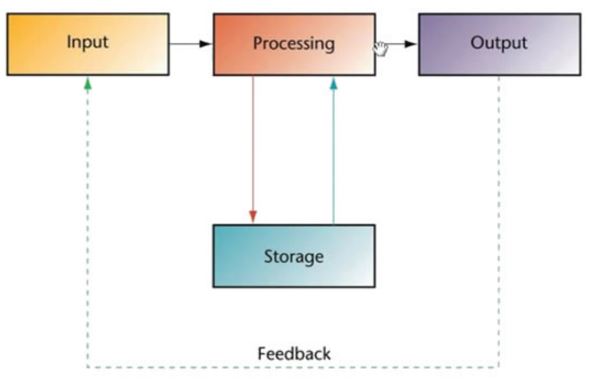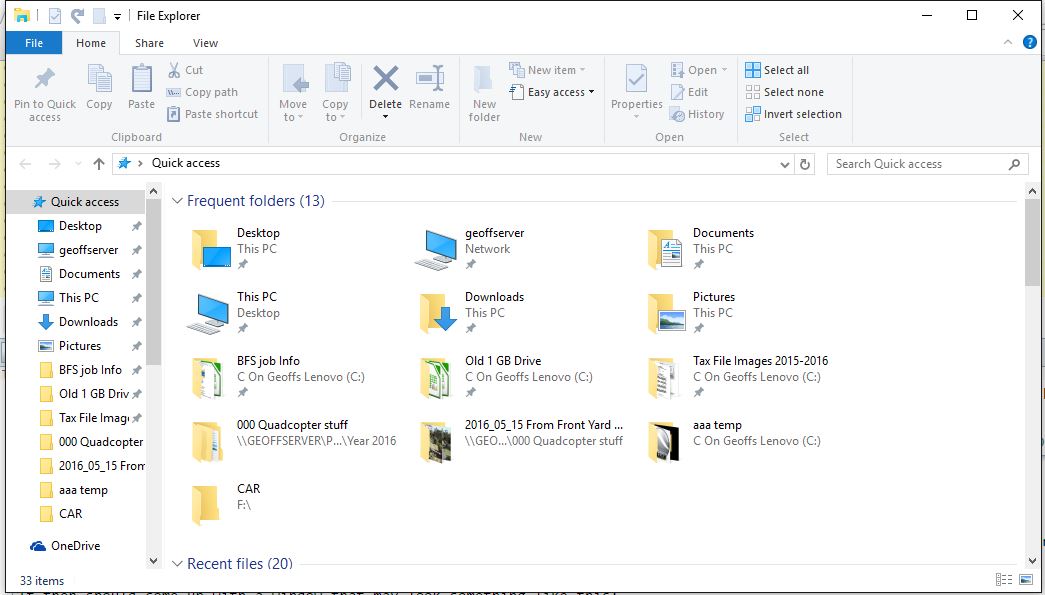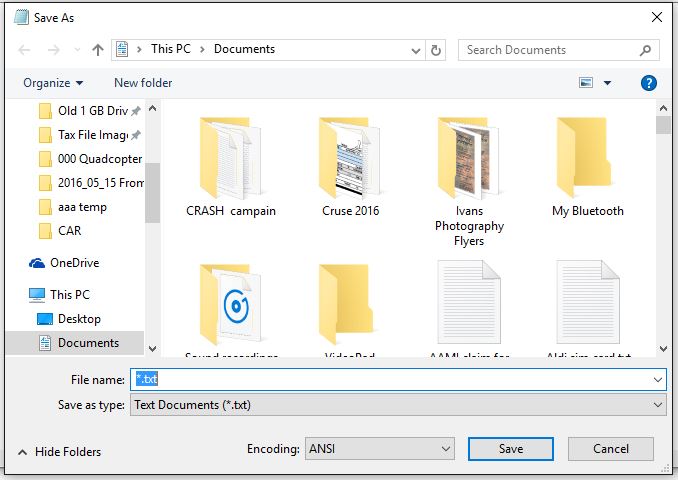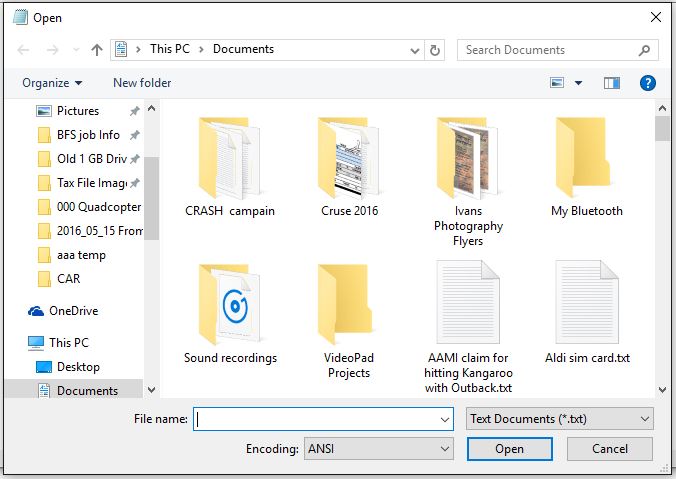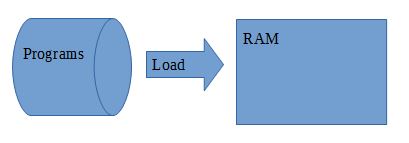Table of Contents
File Explorer in Windows 10
What is it?
It is the filling system of windows 10. It allows you to handle the storage part of the computing process as show in this diagram:
It is what comes up in Windows 10 (used to be called Windows Explorer prior to Windows 8) when you click on a Icon that looks like this, on the Windows 10 Task bar: ![]()
It then should come up with a window that may look something like this:
Although their are many other ways to access it. See How many ways to start a program in Windows
Why use it?
To be able to file your information such as photo, videos, drawings, music, sound recordings and documents within your computer
You dont have to use it. Although you may already be using it, without knowing. See next section.
The Apple Iphones and Ipads as well as some Android Tables and Phones do not allow the end user access to the file system (equivalent to Windows 10 File Explorer) Even within File Explorer much of the files system remains hidden, with hidden or system files. The reason for this is that the developers of these systems felt that allowing end uses access to the file system may end up with the system being messed up. If end uses can not access it, then their is less chance of it getting messed up.
But that could leave end uses with the inability to do the following:
- - Make backup copies of the information they created
- - Correct mistakes
- - Make copies of information available to others
- - Move information around
- - Delete unwanted information
- - Free up storage when it is running out or low
- - Change information about stored information (meta data)
- - Know where your information is being stored, for future retrieval
- - Control how information is organised in your computer
Or even excluding any of the above, if you cannot control the files system, you are effectively relishing control of your computer and the information you create, to the developers of the computer system you are using.
Are you already using it but did not know
Save and Open
If you “save” the information you create on your computer, you should have seen, something like, this “Save As Dialog” window pop up:
If you compare this window with the window of File Explorer, you will see there are a lot of similarities. That is because this “Save As Dialog” is the same program as File Explorer, in a slightly, cut down, (shows less information) format.
The same applies if you wish to retrieve “open” information you have previously created. You will be presented with a “Open Dialog” window that looks like this:
Again it is just a cut down version of the File Explorer window.
Program are Information (files)
Even if you have never saved or retrieved information, on your computer, you have still been using the files system because all programs (what you use to achieve something) are stored in your computers files system. When you start a program, you are telling the files system to open that program. That is, retrieve that program from storage.
Within your computer, the file system is not concerned if the information it stores, is information you entered, (sometimes called user data), or is instructions of what the computer should do, (a program).
Without the files system your computer would not even be able to start because the files system uses special programs call boot loaders to load other special programs call the operating system, to allow you to do the things you do on your computer.
This is why you may have been using File Explorer (a files system) without even realizing it.
Information and the name of the information
My name is Geoff and I am Geoff. But that is just the name I was given. I could change my name, but I would still be the same person.
The same applies to information within a computer. There is the information and there is the name of the information. They are two different things.
It is therefore possible to change the name without changing the information, or change the information without changing the name.
As computers make it extremely easy, if you know how, to copy information, it is possible to have two separate pieces of information but both have the same name. And it is also possible to have two names, that are the same, but refer to different information.
In computing, information is stored in files. And those files are give file names. But, as above, the file and the file name are two different things,
You can create whatever information and save it a file. You decide on the file name, you wish to use, to refer to that file. The file name can be up to about 250 character long and can contain spaces, letters, number and some other symbols. There are some symbols that can not be used in files names.
It is best to use file names that help you remember what information is in the file, but because this is not a requirement, it is possible to have a file name that bears no resemblance to it contents.
File and folder Names, Whats the difference
Files contain information, where as folders are only containers used to store files and make it easier to group files
My name is Geoff, and there are a lot of people with that name. To be able to distinguish me from other Geoffs I also have a family name. And that family name can go back generations, so that it is possible to distinguish me from previous generations with the same name, Geoff, but are in a different generation or hierarchy in the family tree.
Because computers can typically have many thousands of files, rather than only having file names they also have folder names. Folders names are a bit like family names in that they have a hierarchy structure.
Folders can have any name and contain other folders, or files, which in turn can contain other folders and files, and so on, so have the hierarchy structure. Folder names follow the same restrictions as for file names. Files can not contain folders. Only folders can contain other folders.
The conventions used for referring to the relationship of folders is the same as used in families. A child folder is a level below its parent folder and a sibling folders are on the same level.
Within a folder two files or folder can not have the same name.
When using File Explorer the hierarchy structure of folders is shown sideways in the Folder Pane:
Comparison of Computer and Manual filing systems
Manual filing systems typically involve the storage of paper bases records so requiring a system of indicating physically where the pieces of paper are stored. This could be via paper bound together in books or via staples stored in folders and or shelves stored in filing cabinets or racks of shelving with some appropriate labeling on the the physical items involved. Usually only one person can read the material at a time and requires the material to be physically moved from the storage area to some other area and then later moved back again. The storage space required can be quite large and rearranging, reclassifying or moving the material is quite labor intensive because physical items have to be moved. If access to the material is required by multiple sequences, alphabetical, numerical, chronological, order of creation, then either multiple copies of the material need to be stored or additional paper records need to be created and maintained. Typically, because of the effort required, paper based files are not backed up (have multiple copies) so are lost if destroyed.
Computer filing system greatest advantage over paper based systems is the information is not physically moved, so that with appropriate software, like File Explorer, it can easily be saved, retrieved on any basis, read, rearranged, re sequenced, moved, copied, made available to multiple people, have its integrity preserved and backed up with dramatically, relatively, little or no effort.
Using File Explorer
Below are videos showing how to perform some of the functions within File Explorer. As some videos cover multiple functions, I have set the links to the point in the video where the item is explained. It is not necessary to watch all the video if it goes on to show other functions.
Here is a video that shows how to watch YouTube videos:
https://www.youtube.com/watch?v=d-9lHGr48-Q
And how to watch a training video and do what is shows at the same time:
How to start and stop it
This video in the first minute of so, shows a few ways to start it. But ther are many way to do it. See How many ways to start a program in Windows
What are the parts (and panes) of the File Explorer Window and what are they used for
The guy in this video shows each of the parts but does not explain what they all are used for:
How to change the appearance of the File Explorer Window
https://youtu.be/6kNTUzjnzeQ?t=9m55s
This video goes to some of the more advanced functions associated with changing the File Explorer Window
Expanding and contracting folders
In this video the guy does not use the terminology of expanding and contracting but used the term open or closing folders
Showing files in different sequences and filtering files
The part of the below video assumes you are are showing files in Details Mode.
Creating a new folder
https://www.youtube.com/watch?v=B5SkHIfyR9I
https://youtu.be/NwCyh1roEbs?t=45s
This video shows how to create a new folder on the desktop
Deleting a folder
Renaming a folder
This video shows for both files and folders
Copying Files
This video shows copying and moving files and folders
https://www.youtube.com/watch?v=XRKqm2iMkHE
So see the copy bit only:
Moving Files
Moving Folders
Copying folders
Renaming Files
This video shows for both files and folders
Deleting Files
Undoing functions
Multi Selection of Files and Folders
Adding folders to Favorites
Saving and Opening Files
Difference between Save and Save As
https://www.youtube.com/watch?v=9q6_eT-JVkk
And why is important to Know

